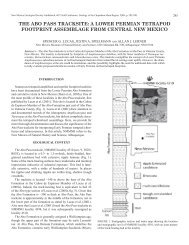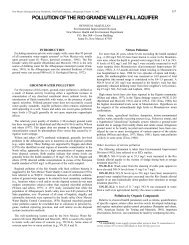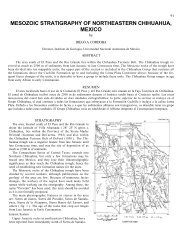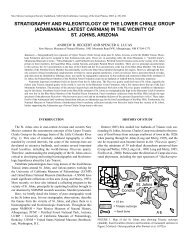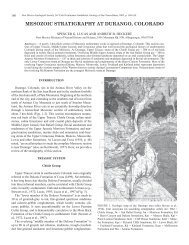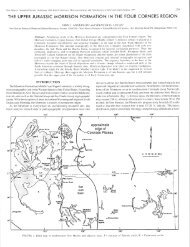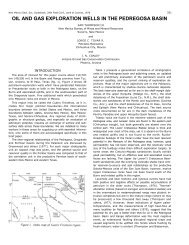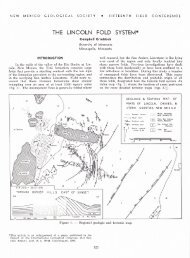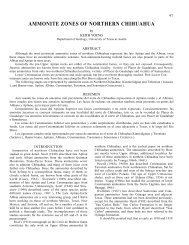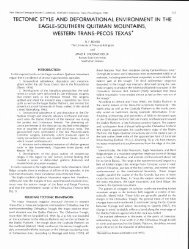When batholiths exploded: The Mogollon-Datil volcanic field
When batholiths exploded: The Mogollon-Datil volcanic field
When batholiths exploded: The Mogollon-Datil volcanic field
Create successful ePaper yourself
Turn your PDF publications into a flip-book with our unique Google optimized e-Paper software.
WHEN BATHOLITHS EXPLODE<br />
FIGURE 2. Idealized stages in the evolution of a resurgent ignimbrite<br />
cauldron and the underlying magma chamber. Actually, no two cauldrons<br />
are alike. <strong>The</strong>y can be asymmetrical (including trapdoor-type halfcauldrons);<br />
stages in development can be omitted or repeated. Modified<br />
from Elston (1984a).<br />
a. Precursor stage: Surface inflation, leakage from the magma chamber.<br />
b. Stage of explosion, eruption, and caldera collapse: Massive ignimbrite<br />
(ash-flow tuff) fills the caldera; the overflow forms a thinner but<br />
widespread outflow sheet. Note the varieties of breccias.<br />
c. Resurgence stage: Defluidized residue leaks from the magma chamber,<br />
forms lava domes. Continued rise of the magma chamber raises the<br />
caldera into a dome, usually (but not always) with a central keystone<br />
graben.<br />
d. Moat and ring-fracture dome stage: Erosion widens the caldera into<br />
a moat filled with pyroclastic and sedimentary deposits. Rejuvenated<br />
magma leaks through ring fractures, forms one or more rings of rhyolite<br />
lava domes. At an intermediate erosion level, the root of the caldera<br />
would be a ring complex with subsided central cauldron.<br />
<strong>The</strong> <strong>Mogollon</strong>-<strong>Datil</strong> Volcanic Field<br />
121<br />
At the core of the <strong>Mogollon</strong>-<strong>Datil</strong> <strong>field</strong>, the <strong>Mogollon</strong> Plateau<br />
(Fig. 3) is a roughly circular basin, drained by the headwaters of<br />
the Gila, and surrounded by a ring of mountains. A controversy<br />
over the origin of lunar craters (impact vs. volcanism) was hot in<br />
the 1960s, and Elston (1965a) cited the <strong>Mogollon</strong> Plateau as a possible<br />
volcano-tectonic terrestrial analog. This suggestion did not<br />
survive the Apollo landings but a NASA-sponsored <strong>field</strong> investigation<br />
eventually evolved into a long-term UNM group project<br />
with various sponsors. <strong>The</strong> first year, 1964-65, laid an early basis<br />
for a developing stratigraphic framework (Elston, 1965b), including<br />
a sequence of ignimbrite sheets and intertonguing intermediate-to-mafic<br />
lavas. <strong>The</strong> mountainous rim of the Gila Basin holds<br />
a discontinuous ring of rhyolite lava flows and domes, of several<br />
post-29 Ma ages. By analogy with the Valles Caldera, it could be<br />
interpreted as the surface expression of a ring complex and the<br />
entire <strong>Mogollon</strong> Plateau as the surface expression of a composite<br />
batholith, 125 km in diameter (Fig. 3; Elston et al., 1976a). Its<br />
existence was confirmed by the gravity survey of Krohn (1976).<br />
Taking a cue from the USGS San Juan experience, cauldrons were<br />
identified, superimposed on the pluton(s) (Coney, 1976; Rhodes,<br />
1976, Deal and Rhodes, 1976). <strong>The</strong> first decade of work (by the<br />
UNM Group and many others) was summarized in a memorial<br />
volume dedicated to Rodney Rhodes (Elston and Northrop, 1976)<br />
and a <strong>field</strong> guide (Chapin and Elston, 1978).<br />
It appears that prior to 31 Ma, cauldrons developed over<br />
widely scattered plutons; after 29 Ma siliceous magmatism was<br />
consolidated into a batholith 125 km wide, outlined by the rhyolite<br />
lavas of the <strong>Mogollon</strong> Plateau ring complex. <strong>The</strong> Magdalena-San<br />
Mateo Mountains cauldron cluster may be underlain by<br />
a separate pluton. Figure 3 shows the outline of only the inferred<br />
post-29 Ma pluton(s). Between ~31 and 29 Ma and after ~24<br />
Ma, dark high-Fe intermediate-to-mafic magmas, largely mantlederived,<br />
were able to reach the surface, unhindered by a pillow of<br />
low-density siliceous magma. Figure 4 shows the alternation of<br />
siliceous and intermediate-to-mafic magmatism.<br />
By the late 1960s and into the 80s, other groups had become<br />
active, notably from the USGS in the <strong>Mogollon</strong> Mountains (Ratté<br />
and Gaskill, 1975; Ratté et al., 1984; Ratté; 1989) and Black<br />
Range (Erickson et al., 1970; Hedlund, 1977), <strong>The</strong> Bureau in<br />
the Socorro-Magdalena area (Chapin et al., 1978; Osburn and<br />
Chapin, 1983; Chapin, 1989), NMSU in the Las Cruces area<br />
and Black Range (Seager, 1981; Seager et al., 1976, 1982), and<br />
other academic institutions (e.g., Sr-isotope studies by Stinnet<br />
and Stueber, 1976, and Bikerman, 1989). <strong>The</strong> <strong>Mogollon</strong> Plateau<br />
pluton was reconfirmed by gravity and seismic studies of<br />
Schneider (1990). Additional names can be found in Ratté et al.<br />
(1989), Elston (2001), and Chapin et al. (2004). Documentation<br />
for cauldrons in Figure 3 is uneven; more details can be found in<br />
the extended caption of figure 2 in Elston (1984a). <strong>The</strong>re are indications<br />
of other cauldrons, but documentation is insufficient for<br />
inclusion in Figure 3. Another cauldron cluster is located in the<br />
Boot Heel (Deal et al., 1978; modified by McIntosh and Bryan,<br />
2000).




